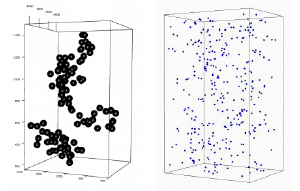Blog
Calling the Question
16 September 2014
A couple days ago I wrote about a rather large cluster of quasars, and how it seemed to be larger than we’d expect for the universe as we know it. The post gathered the attention of an anonymous commenter, who pointed out an opposing view regarding this research. The rebuttal to the cluster research was published in MNRAS, and makes a rather simple claim: not all patterns are real.1 In other words, if you look deep enough for a pattern in your data, you are bound to find one, even if it is really just noise.
The argument that “you can always find a pattern if you look for one” is a pretty standard rebuttal in data analysis. It is much like the old “correlation is not causation” argument. While both statements are basically true, simply stating them doesn’t buy you much. In data analysis, distinguishing the signal from the noise is a central part of the work, so we’re generally pretty careful to avoid false positives. So if you’re going to counter a research finding with “it’s just noise” you better be able to back up your claim with solid evidence. In this case, the new paper makes a pretty solid argument. As the author points out, what constitutes a “structure” depends a great deal how you define your connections between objects.
As an example, suppose you wanted to define the typical size of a person’s community. You could define a person’s community as only those people who are close friends. By that definition most communities would be quite small, usually less than a dozen. That’s probably not very accurate, so you could extend it to close friends and close acquaintances. Or perhaps even more broadly friends, acquaintances and their acquaintances. Define things too broadly and all of humanity is in the single community of Kevin Bacon. Define it too narrowly and we all look like social recluses. The reality is somewhere in the middle, with a mix of friends and acquaintances.
With quasars you can use a similar definition. Specifically, if two quasars are within a certain distance of each other, they can be considered part of the same cluster. If a third quasar is within that distance of either of the other two, it is also part of the cluster, and so on. Obviously, the distance you define for the will affect the scale of your cluster. Make that distance too small, and clusters are small and rare. Make it too large, and you get a cluster that spans most of the universe. In the original paper the minimum distance was set at 100 megaparsecs, or about 325 million light years. That’s pretty big considering that our local cluster of galaxies (the local group) is only about 10 megaparsecs across. But is that distance too big to be meaningful? This new paper argues that it is.
 Clowes/Nadathur
Clowes/NadathurTo demonstrate this, the author looked at just how likely false positives were under this definition. They ran simulations of randomly distributed quasars, so that they satisfied the condition of homogeneity, then calculated how often a super-large cluster appeared by chance alone. The result was that such super clusters were rather common. Finding a cluster 4 billion light years wide isn’t that unusual. So it’s hard to say that the cluster is a legitimate structure. It certainly shouldn’t be seen as very unusual.
On their blog, the author hammers the point home by visually comparing the cluster with other quasars in the region, as you can see in the figure. If you only include members of the cluster and make your dots big, then it seems pretty clear. If you make the dots smaller and include all quasars in the region, the cluster doesn’t look quite as convincing.
Sometimes a mystery raises deep questions about our understanding of the cosmos. Sometimes it simply fades away when you look at things a bit more carefully.
Nadathur, Seshadri. “Seeing patterns in noise: gigaparsec-scale ‘structures’ that do not violate homogeneity.” Monthly Notices of the Royal Astronomical Society 434.1 (2013): 398-406. ↩︎